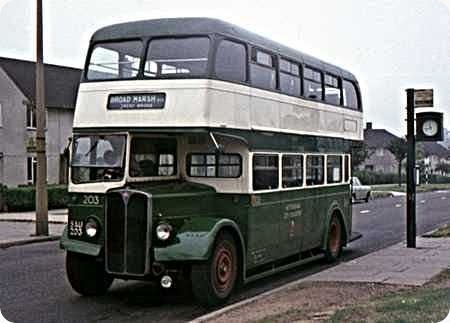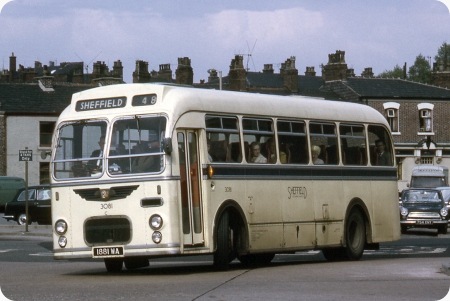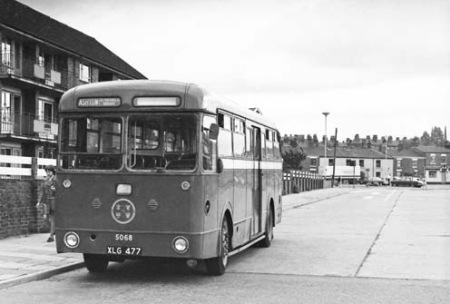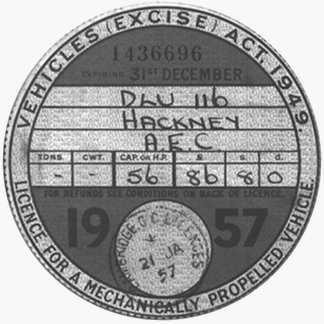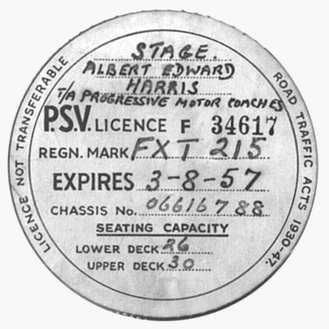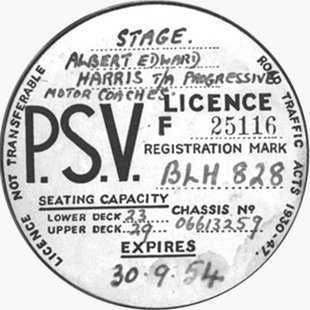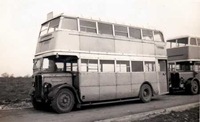Nottingham City Transport – AEC Regent III – SAU 203 -203
Nottingham City Transport
1954
AEC Regent III 9613S
Park Royal L27/26R
After Nottingham City Transport had obtained the ex Bradford lowbridge Daimlers to start the services to the then newly developing Clifton Estate, an existing order for Park Royal bodied AEC Regent IIIs was amended, and 10 were delivered in April and June 1954 with lowbridge bodies as 199-208 (SAU 199-208).
These lowbridge vehicles were needed as the railway bridge on Wilford Lane (ex GC main line) precluded highbridge deckers being used.
However, in March 1958, another bridge over the River Trent was opened, and NCT services serving Clifton Estate were diverted over this new bridge, known as Clifton Bridge. This meant NCT no longer needed lowbridge vehicles, but West Bridgford and South Notts continued to use Wilford Lane.
By 1964/5, I think the lowbridge Regents tended to be used on works extras, and service 2, between Goldsmith Street and Valley Road.
The first of the batch were withdrawn in early 1967, when 199-202 were taken out of service and sold. 199 stayed locally, becoming Barton 1087 until 1972, when it was withdrawn and exported to America.
However, in September 1968, NCT took over the West Bridgford fleet and inherited their Clifton services with its lowbridge requirement.
At this point, the remaining SAU Regents, 203-8, came into their own again, reappearing on the Wilford Lane services to Clifton, quickly replacing the non standard pair of ex WBUDC Willowbrook bodied Regent IIIs, ORR 139/40, which were 6812A chassis, with the 7.7 engine and crash gearbox, rather than the 9.6 engine and synchromesh gearbox of the SAUs.
These buses were delivered in the traditional NCT livery of green with three cream bands, but all were repainted in the brighter livery adopted in the early 1960s.
203 was photographed in August 1969, at the Clifton terminus of service 67.
203-8 were withdrawn in 1970/1, along with the ex WBUDC Reading bodied Regent Vs, and were replaced by Atlanteans 395-400 (VAU 395-400J), which were a special lowheight version of the then standard Nottingham design on PDR1/3 chassis.
As a postscript, history repeated itself a few years later when the Atlanteans were themselves rendered surplus to requirements as lowheight vehicles early in their life, with the removal of the low railway bridge on Wilford Lane in autumn 1974. They remained in the fleet until withdrawn in 1981, when five of the six were exported to Hong Kong, via Paul Sykes, but that’s another story!
Photograph and Copy contributed by Bob Gell
A full list of Regent III codes can be seen here.
19/01/12 – 05:42
OK, I’ll be the smart alec that reckons this must have been a Saturday morning (assuming the timetable was still the same as two years later). The clock shows 11.43. On Mondays – Fridays, the 67 only ran via Trent Bridge hourly, and its departure time from Langstrath Road was 41 past. Sundays it was hourly at 56 past. But on Saturdays it was every 24 minutes, and on the odd hours this was 00, 24 and 48 past. The journey to Broad Marsh took 22 minutes – it was only 19 via Clifton Bridge. For many years the numbers were the same by either route.
Stephen Ford
19/01/12 – 12:32
Stephen – Spot on! August 2nd, to be precise.
Thanks for the additional information.
Bob Gell
19/01/12 – 12:32
Timetables on the buses on Clifton ?!?! We never needed to bother. All the services from Nottingham to Clifton entered Clifton at the same road and then spread out to different terminus points within the Estate. We lived in a house located before the buses spread out, so we could use any of the route numbers from Nottingham. And on the return journey out of Clifton we were at the point where all the services converged, so all the different routes went past our bus stop. Never had to wait more than a few minutes for anything
KC
19/01/12 – 17:58
Timetabling to serve three different termini, each by two different routes, with different end to end journey times, and joint working with South Notts on the Trent Bridge services, was quite complex – especially when you remember that the actual buses were not interchangeable between the Clifton Bridge and Trent Bridge variants! The main routes were 61A, 67 and 68, each running either via Clifton Bridge or Trent Bridge. The 61 and 66 were by this time rush hour short workings. Monday-Friday daytime had a combined 10 minute interval service via Clifton Bridge (half-hourly to each terminus). There was a 20 minute interval service via Trent Bridge (hourly to each terminus). Overall, buses left Broad Marsh in a repeating sequence of 10,5,5,10,5,5 minutes. On Saturdays, all six services (three by each bridge) ran on a 24 minute headway. You might expect this to level out to an overall 4 minute interval service (every 8 minutes via each bridge). Such was not the case, however, no doubt for good logistical reasons. Instead the Saturday departures from Broad March were in the repeating sequence of 6,4,2,6,4,2 minutes, and the interval over each of the bridges was 6,10,8,6,10,8 etc. I wonder who worked that lot out!
Stephen Ford
20/01/12 – 07:39
I note the photo was taken in 1969. So I’m sure one of the experts can answer the question "When did Nottingham City Transport finally stop using open rear platform buses?". My memory (unreliable) tells me that there weren’t any beyond the early 1970s. They seemed to disappear relatively early compared to other operators.
KC
20/01/12 – 07:40
Of course it’s obvious now but something which hadn’t really occurred to me before is that South Notts had a strong presence at both Huntingdon Street and Broad Marsh. Was there ever anyone on hand to supervise the departures or were they left to their own devices? I’m not suggesting for a moment that they (or the others) would have been anything less than professional but as Stephen says, it was a complex operation. I wonder if South Notts rosters contained any inter-working with the Loughborough service or if Clifton services were kept totally separate?
Chris Barker
20/01/12 – 12:32
They had exposed radiator AEC Regent Vs running in 1971 The last open platform deckers bought dated from 1959 so withdrawal in the seventies would be reasonable.
Chris Hough
20/01/12 – 12:33
KC NCT’s last open platform buses were withdrawn in 1976. (11 Regent Vs from 1956, and 6 PD2s from 1959). The final ex WB Regent Vs had been withdrawn in 1974.
The last half cabs in the fleet, the 1965 Renowns, were withdrawn in 1976/7.
Bob Gell
22/01/12 – 06:50
Unlike many, I quite like the enclosed Regent V front, but – like the PD2s and PD3s – I do prefer the exposed radiators. There is a dignity in style which is missing on so many "tin fronts".
David Oldfield
23/01/12 – 07:48
I think the reason for the emergence of the tin front was the revolution in the appearance of single deckers. Half-cab single deckers became obsolete almost overnight in 1951, making double deckers look dreadfully old-fashioned by comparison with the new underfloors.
I must say that as a bus-mad child in the 1950s I was completely sold on the idea. I thought the tin-front Leylands of Oldham and Southport looked far better than Manchester’s archaic exposed radiators. It was only when the tin fronts themselves started to look dated that the traditional purity of the exposed radiator won out over the (by then) out dated attempt to disguise it.
The enclosed Regent V front looked like a reshaped radiator rather than a disguised one. Car manufacturers had already started doing the same thing, retaining the distinctive features of their traditional radiators in their new grilles but in a lower, wider shape (the most obvious comparison is Rover), and by common consent AEC’s approach was more successful and stylistically durable than the others.
Peter Williamson
27/01/12 – 06:37
Am I right in thinking that in my time at Nottingham (66-69) one make (AEC or Leyland) was in the majority on Derby Road north of the university campus, and the other make in the majority on University Boulevard south of the campus? or does my memory play tricks? Atlanteans were in evidence from City centre to Trent Bridge for the football, but I only recall open platform designs serving the University. I do remember once travelling in a lowbridge side gangway vehicle from University boulevard to Beeston. I also remember a late night city centre start with a full bus and flat battery, the bus was facing uphill so reverse was engaged and the engine started with no problem.
Nigel Richards
27/01/12 – 11:14
Nigel, the 5 (Beeston via Derby Road) and 5A (via Castle Boulevard) were certainly operated by the same buses. They ran as a circular route – outward as a 5, inward as a 5A and vice versa. This avoided the need to reverse in the congested centre of Beeston before the bus station was built. However it may well be that the other north side services (19 and 63) used a separate group of vehicles from the other south side services (4 and 4A). Both the 4 and 5 displayed "Beeston via Derby Road" but they were completely different routes. The 4 turned off Derby Road at Gregory Street, Old Lenton, joining the 4A route along the southern perimeter of the campus (University Boulevard). The 4 and 4A avoided the reversal problem by continuing beyond Beeston Square along Chilwell Road, and round the block Collin Street, Gladstone Street to terminate at Imperial Road.
Stephen Ford
28/01/12 – 06:42
Nigel, Stephen
I seem to remember that in 67/8, 4,4A, 5,5A were a 50/50 split between AEC Regent Vs and Leyland PD2s. Don’t know about 19 and 63 though.
Bob Gell
28/01/12 – 14:35
Hi Bob, yes, you are probably right. My point really was that there couldn’t have been an operational segregation between the "south side" and "north side" services, since the 5 and 5A at least were the same vehicles running out by one route and in by the other. I think by this time the Regent Vs and PD2s were the only back-loading half-cabs left (and no doubt many of these had also been withdrawn). I can’t remember whether the Renowns ever got onto these routes. Incidentally, in checking with the 1971 timetable, I discovered that the 63 was routinely scheduled a 15 minute layover at the outer terminus (Wollaton Vale) – 20 minutes journey and 15 minutes layover. Nice work if you can get it!
Stephen Ford
03/05/12 – 08:56
Bob – I think the SAU Regents became an embarrassment to NCT after the diversion of their Clifton services via Clifton Bridge. Here was a batch of ten buses no more than four years old and with three years of the initial certificates of fitness still to run with no real work to do. As you say they found employment on works services. The only requirement for lowbridge buses was the once or twice a week service to the White City dog track on Trent Lane from Clinton Street. I recall seeing an SAU regularly on a service 4 going into Nottingham when on my way home from work during 1967.
Stephen – in 1969 there was still a 30 minute service on Sundays via both bridges.
In the days of NCT/WBUDC and South Notts sharing the service the number of buses required was:-
NCT (via Clifton Bridge)
Sunday – 5 buses
Monday to Friday peaks – 11 buses
Monday to Friday inter peak – 5 buses
Monday to Friday evenings – 5 buses
Saturday daytime – 6 buses
Saturday evening – 5 buses
South Notts/WBUDC (via Trent Bridge)
Sunday – SN – 3 buses; WB 2 buses
Monday to Friday am peak – SN 7 buses; WB 5 buses
Monday to Friday morning interpeak – SN 2 buses; WB 1 bus
Monday to Friday afternoon interpeak – SN 1 bus; WB 2 buses
Monday to Friday pm peak SN 6 Buses; WB 6 buses
Monday to Friday evenings – SN 2 buses; WB 1 bus
Saturday daytime SN 4 buses; WB 3 buses
Saturday evening SB 3 buses; WB 2 buses.
NCT was the major operator with 55% of the mileage operated. South Notts had 25% and West Bridgford 20%.
Chris – South Notts Clifton workings were kept separate from its ‘main line’ services. There were some early morning journeys from Gotham garage running out to take up service at Clifton advertised and passengers using these journeys had to pay the relevant fare from Clifton as well as a fare from Gotham to Clifton.
On the question of supervision, although South Notts had two Inspectors I cannot remember seeing them at Broad Marsh during the period I was using Clifton services. I did however see NCT Inspectors at Broad Marsh – mainly during the teatime peak – observing departures of NCT buses. West Bridgford also had Inspectors but I don’t remember seeing them at Broad Marsh.
Michael Elliott
23/05/12 – 09:12
Thanks for all the insight into early Clifton Estate runnings, I must admit it has always confused me how the percentages were worked out. Certainly a lot more interesting than todays services on the Estate!
Gareth Perkins
24/11/20 – 06:50
Better late than never, this is a response to Nigel Richards on 27/01/12 – 06:37 and Stephen Ford (not related to me!) on 27/01/12 – 11:14. My memory tells me that in my time in Nottingham (1961-1964) the 4 and 4A were operated by AEC Regents (XTO etc) (as were the City – Arnold services). The 5 & 5A were operated by older AEC Regents (KTV etc), as were the 19 & 63. I used the 6, 17, 18 & 28 via Hucknall Road and the 45 via Derby Road, these were operated by Leyland PD2’s (ATO reversed registrations), these were newer but much lighter weight with a consequent bumpier ride than the Regents.
Vernon Ford
25/11/20 – 07:49
Hello Vernon (true – we aren’t related!) My recollection is that certain groups of routes had more or less dedicated series of vehicles, whereas others were operated with a more eclectic mix. Certainly the Bilborough group – served from Bilborough Depot, were almost exclusively the OTV series Regent IIIs (prior to that ISTR it was pre-war Regents, plus some of the KTV 100 series (actually 97-126) on the 13, 56 and later 60. The Arnold routes (10, 20, 20A, 52, 57 and later 69) pl us the Mapperley 31 were served from Sherwood Depot by their fleet of XTO Regent Vs, as you say. Before their arrival most were in the hands of pre-war Regents, supplemented by the 1948/49 KTV 200 series Daimler CVD6s – which were nearly ubiquitous on the 31. I think the Beeston routes were served by Parliament Street Depot, and may have had a bit more variety (the 4/4A was a cross city service from Arnold until about 1952). I recall the KTV 100 Met Cam, KTV 300 Roberts, and OTV Park Royal Regents, plus the XTOs. I lived in Aspley until 1954, on the Hanley Street (1, 7 and 22) routes – which at that time and for some years after were virtually always KTV 300s from Bulwell depot, with just a few extras at peak hours, that might be pre-war Regents or Utility Guys or Daimlers. 1958 PD2s introduced Clifton Bridge routes, when the bridge was first opened, and also the Trinity Square series as you say. The seat spacing was a bit cramped with very upright seat-backs, but on the whole I liked them.
Stephen Ford
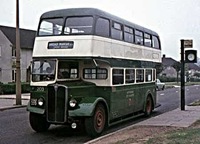 Vehicle reminder shot for this posting
Vehicle reminder shot for this posting
01/12/20 – 05:40
Stephen, your comment about the PD2’s seats being very upright is true – is my memory correct that the seat width was the same as would have been used on 7′ 6" wide buses? The gangway always seemed very wide. Also you mention the 1948/49 CVD6’s, by the time I got to Nottingham in 1961 these were generally out of use except for rush-hours, I had many a ride on them to the University. At that date there was no regular service onto Highfield Campus, only two or three buses arriving just before 9am.
Vernon Ford
03/12/20 – 06:40
Vernon, not too sure about the seat widths on the PD2s. My first experience of one, virtually brand new, was on a tour of Nottingham, which NCT used to operate on occasional bank holidays. The CVD6s were a postwar purchase, bought, I suspect, to replace pre-war Regents on the 31 with its steep hills. I have read that in the early post-war period AEC (Henry Ford style – also no relation!) would supply any mechanical configuration as long as it was 7.7 litre and crash gearbox! NCT wanted a bit more "umph" for Woodborough Road and the CVD was 8.6 litre – and of course, pre-selector. The strange thing is that subsequently I don’t ever remember seeing any 9.6 litre Regent III on the 31 – even though the KTV100s and 300s arrived in quick succession about the same time in 1948/49.
Stephen Ford
Quick links to the - Comments Page - Contact Page - Home Page
